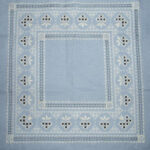Today’s sheer curtains are light, filmy lengths of patterned or plain fabric that let sunlight filter into a room creating an airy feel.
Stylish new fabrics, woven or printed with exquisite designs and trimmed with delicate borders, bring fresh style to sheer curtains. These new printed sheers perform the traditional role of screening out direct sunlight, while their patterns and prints cast a light breezy aura across the room.
When choosing your fabric, keep in mind the room’s use. What looks marvelous in a bathroom may not have the sophistication needed for the more formal setting of a living or dining area.
Coordinating sheer and standard furnishing fabrics are also widely available, making mix and match schemes easy to achieve.
If there is an unattractive outlook from a window, opt for lightweight, opaque curtains. They hide the view and provide privacy, while still allowing any daylight to bathe the room.
Translucent heading tapes, designed specifically for sheer curtains, are available in a range of pleat styles. They are balanced and sized to suit lightweight fabrics, forming fine folds and drapes.
For fixed curtains, those that do not need to be drawn there are also healing tapes with an inbuilt touch and close fastening strip, eliminating the need for a track and hooks. The strip is attached to the window frame or surround, and the completed curtains are pressed in place.
To make the sheer curtains you will need:
- Tape measure
- Meter stick (optional)
- Tailors’ chalk
- Sheer fabric
- Matching sewing thread
Making sheer curtains is very similar to making simple unlined curtains, except that the seams are self neatening and hems have to be double to disguise raw edges. These instructions include methods for neatening both side and base hems.
If you have chosen a fabric of the correct width, with trimmed or neatened selvedge edges, just stitch the lower hems and add a heading tape.
Alternatively, if you have chosen a sheer to a specified length with a decorative trimmed or neatened lower edge, and a ready-made heading, you only need to stitch the side edges.
If you are adding a heading tape, you must provide a firm foundation with a double hem, the width of the tape, all along the upper edge.
Sheer fabrics are slippery, which makes them a little hard to cut. To make it easier, cover the cutting surface with an old sheet, then lay the sheer on top and cut one layer at a time. A meter stick helps in measuring up and straightening the raw end, as its weight stops the fabric from moving.
1. Calculating fabric amounts: Measure the window width, add 3 ¼ inches (8cm) for both side hems and, if joining widths, an extra 1 ¼ inches (3cm) for every seam. Multiply this width of fabric according to gathering allowance for heading tape chosen. Measure the window height, adding 3 ¼ inches (8cm) for the base hem plus one width of the heading tape.
2. Cutting out: Lay the fabric flat and trim the base edge straight. Measure the curtain length up from the base edge and, using chalk, mark the top edge. Cut across the fabric following the marked line. Repeat, as necessary. Stitch widths together with flat fell seams.
To do a flat fell seam, firstly sew a straight seam. Trim the underneath seam allowance to ¼ inch (6mm) and press the allowances to one side.
Next fold the top allowance over the underneath allowance, turning under the raw edge to enclose the trimmed edge. Pin and press flat. Tack then sew through all the layers close to the folded edge. Press well.
3. Stitching the hems: Turn under a ¾ inch (2cm) double hem along both side edges. Pin, tack and machine stitch both side hems. Turn under a 1 ½ inch (4cm) double hem along the base edge, forming neat corners. Pin and stitch base hem.
4. Neatening the top edge: Turn under and press the top edge of the curtain to just less than the width of the heading tape. Position the tape along the top edge and pin in place.
5. Stitching on heading tape: Tack and machine stitch the heading tape in place, trimming and turning in the raw ends for 3/8 inch (1cm). Leave the gathering cords loose at one end and catch them down at opposite end.
6. Pleating up curtains: Pull up the heading tapes tightly to set the pleats in position, and then gently ease out until the curtain is the correct width for the window. Insert the curtain hooks, placing one at each end and the rest spaced approximately 3 ¼ inches (8cm) apart.
Tips to shrink proof your curtains. Sheer fabrics, especially in cotton, may shrink. As a preventative measure, you can either pre-shrink this type of fabric by washing it before sewing or, if you prefer, stitch a triple, rather than a double hem. Then, if the curtains shrink there is an allowance to let down.







